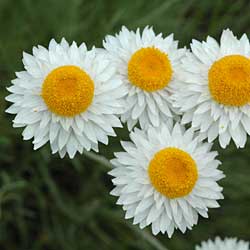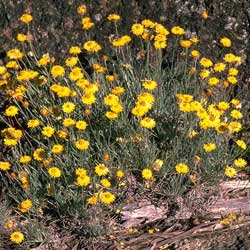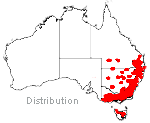Leucochrysum albicans
 flower heads with white inner bracts |
 with yellow inner bracts, in the wild |
Hoary Sunray
Leucochrysum albicans (A.Cunn.) Paul G.Wilson (1992)
Leucochrysum albicans (formerly called Helipterum albicans) is commonly known as the Hoary Sunray and is a member of the daisy family, Asteraceae. It is a small, spreading perennial herb with grey-green foliage, and an inflorescence of a single flower head with a yellow disc centre and papery yellow or white radiating bracts. These attractive flower heads, which retain their colour when dried, make L. albicans horticulturally desirable for fresh and dried cut flowers.
Within the species L. albicans there are two subspecies, L. albicans subsp. albicans and L. albicans subsp. alpinum. The subspecies L. albicans subsp. albicans includes three varieties, L. albicans subsp. albicans var. albicans, var. buffaloensis, and var. tricolor. Both L. albicans subsp. albicans var. albicans and var. buffaloensis have yellow disc centres and yellow inner bracts, while L. albicans subsp. albicans var. tricolor and L. albicans subsp. alpinum have yellow disc centres and white inner bracts.
The flowering period of L. albicans begins between August and December, and ends in March, with variation between the different subspecies and varieties.
 L. albicans occurs in all the eastern states. L. albicans subsp. alpinum is restricted to alpine regions of New South Wales, the Australian Capital Territory and Victoria while L. albicans subsp. albicans var. buffaloensis is endemic on Mt. Buffalo, Victoria. L. albicans subsp. albicans var. tricolor is listed as endangered under the EPBC Act*.
L. albicans occurs in all the eastern states. L. albicans subsp. alpinum is restricted to alpine regions of New South Wales, the Australian Capital Territory and Victoria while L. albicans subsp. albicans var. buffaloensis is endemic on Mt. Buffalo, Victoria. L. albicans subsp. albicans var. tricolor is listed as endangered under the EPBC Act*.
In cultivation, L. albicans suits both gardens and containers, and requires well-draining soil of pH 6-7. L. albicans generally prefers dry sites in full sun, and will not tolerate over-watering. It is frost tolerant to -5˚C.
L. albicans subsp. albicans var. albicans and var. tricolor are the varieties best suited for cultivation in the Canberra region. Those living in cool mountain areas may have success with L. albicans subsp. alpinum, which also prefers moister soils. L. albicans subsp. albicans var. buffaloensis is not suitable for garden cultivation, though may be grown in containers kept in a cool area. L. albicans will not grow in tropical climates.
Methods of propagation are from seeds or cuttings. Cuttings will strike readily and seeds will usually germinate within 7-20 days of sowing. All subspecies and varieties should be watered in well when first planted, then weekly by drip irrigation. Mulching with inorganic material such as pebbles or stones during summer is important to keep the roots cool. L. albicans responds well to small doses of fertilizer, particularly nitrogen and potash. Pruning the flower heads encourages new growth and a longer flowering period; cutting the flower heads to arrange fresh or dried will satisfy L. albicans’ pruning requirements. Pests of the everlasting daisies include slugs, snails, aphids, caterpillars and red-legged earth mites, all of which can be controlled effectively with appropriate pesticides.
*Environment Protection and Biodiversity Conservation Act 1999 (Cth) – see http://www.deh.gov.au/epbc/.
Text by Victoria Challinor (2006 Student Botanical Intern)
Name meaning:Leucochrysum - derived from the Greek words leukos meaning white, and chrysos meaning gold, in reference to the yellow disc centre and white inner bracts of L. albicans subsp. albicans var. tricolor and L. albicans subsp. alpinum. albicans - from the Greek albescens meaning becoming white, referring to the inner bracts of L. albicans subsp. albicans var. tricolor, which may open yellow and fade to white |
References
Barker, J. et al. (Australian Daisy Study Group) (2002) Everlasting Daisies of Australia, C.H Jerram and Associates Science Publishers, Melbourne, p.1, 7-12, 104-109.
Johnson, A.T. and Smith, H.A. (1986) Plant Names Simplified, Hamlyn Publishing Group Ltd.
Wilson, P.G. (1992) The classification of Australian species currently included in Helipterum (Asteraceae: Gnaphalieae): Part 2 Leucochrysum, Nuytsia 8(3):439-446.
![An Australian Government Initiative [logo]](/images/austgovt_brown_90px.gif)

